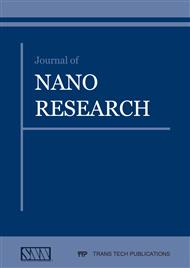[1]
J. Schiotz, F.D. Di Tolla, K.W. Jacobsen, Softening of nanocrystalline metals at very small grain sizes, Nature 391 (1998) 561-563.
DOI: 10.1038/35328
Google Scholar
[2]
V. Swygenhoven, P.A. Derlet, Grain-boundary sliding in nanocrystalline fcc metals, Phys Rev B. 64 (2001) 2241051-9.
DOI: 10.1103/physrevb.64.224105
Google Scholar
[3]
J.W. Cahn, Y. Mishin, A. Suzuki, Coupling grain boundary motion to shear deformation, Acta Mater. 54 (2006) 4953-4975.
DOI: 10.1016/j.actamat.2006.08.004
Google Scholar
[4]
J.W. Cahn, J.E. Taylor, A unified approach to motion of grain boundaries, relative tangential translation along grain boundaries, and grain rotation, Acta Mater. 52 (2004) 4887-4898.
DOI: 10.1016/j.actamat.2004.02.048
Google Scholar
[5]
M. Legros, D.S. Gianola, K.J. Hemker, In situ TEM observations of fast grain-boundary motion in stressed nanocrystalline aluminum films, Acta Mater. 56 (2008) 3380-3393.
DOI: 10.1016/j.actamat.2008.03.032
Google Scholar
[6]
Z. Budrovic, H. Van Swygenhoven, P.M. Derlet, S. Van Petegem, B. Schmitt, Plastic deformation with reversible peak broadening in nanocrystalline nickel, Science 304 (2004) 273-276.
DOI: 10.1126/science.1095071
Google Scholar
[7]
M.W. Chen, E. Ma, K.J. Hemker, H.W. Sheng, Y.M. Wang, X.M. Cheng, Deformation twinning in nanocrystalline aluminum, Science 300 (2003) 1275-1277.
DOI: 10.1126/science.1083727
Google Scholar
[8]
S. Cheng, J.A. Spencer, W.W. Milligan, Strength and tension/compression asymmetry in nanostructured and ultrafine-grain metals, Acta Mater. 51 (2003) 4505-4518.
DOI: 10.1016/s1359-6454(03)00286-6
Google Scholar
[9]
C.C. Koch, R.O. Scattergood, K.A. Darling, J.E. Semones, Stabilization of nanocrystalline grain sizes by solute additions, J Mater Sci. 43 (2008) 7264-7272.
DOI: 10.1007/s10853-008-2870-0
Google Scholar
[10]
J. Weissmuller, Alloy effects in nanostructures, Nanostruct Mater. 3 (1993) 261-272.
Google Scholar
[11]
H.Q. Li, F. Ebrahimi, An investigation of thermal stability and microhardness of electrodeposited nanocrystalline nickel-21% iron alloys, Acta Mater. 51 (2003) 3905-3913.
DOI: 10.1016/s1359-6454(03)00215-5
Google Scholar
[12]
T. Shanmugasundaram, M. Heilmaier, B.S. Murty, V.S. Sarma, On the Hall–Petch relationship in a nanostructured Al–Cu alloy, Mater. Sci. Eng. A. 527 (2010) 7821-7825.
DOI: 10.1016/j.msea.2010.08.070
Google Scholar
[13]
H. Bahmanpour, K.M. Youssef, J. Horky, D. Setman, M.A. Atwater, M.J. Zehetbauer, R.O. Scattergood, C.C. Koch, Deformation twins and related softening behavior in nanocrystalline Cu–30% Zn alloy, Acta Mater. 60 (2012) 3340-3349.
DOI: 10.1016/j.actamat.2012.02.036
Google Scholar
[14]
C.A. Schuh, T.G. Nieh, H. Iwasaki, The effect of solid solution W additions on the mechanical properties of nanocrystalline Ni, Acta Mater. 51 (2003) 431-443.
DOI: 10.1016/s1359-6454(02)00427-5
Google Scholar
[15]
H.Q. Sun, Y.N. Shi, An investigation on Hall-Petch relationship in electrodeposited nanocrystalline Cu-Ni-P alloys, J. Mater. Sci. Technol. 25 (2009) 347-350.
Google Scholar
[16]
A. Giga, Y. Kimoto, Y. Takigawa K. Higashi, Demonstration of an inverse Hall–Petch relationship in electrodeposited nanocrystalline Ni–W alloys through tensile testing, Scripta Mater. 55 (2006) 143-146.
DOI: 10.1016/j.scriptamat.2006.03.047
Google Scholar
[17]
T.D. Shen, R.B. Schwarz, S. Feng, J.G. Swadener, J.Y. Huang, M. Tang, J. Z Zhang, S.C. Vogel, Y. S Zhao, Effect of solute segregation on the strength of nanocrystalline alloys: Inverse Hall–Petch relation, Acta Mater. 55 (2007) 5007-5013.
DOI: 10.1016/j.actamat.2007.05.018
Google Scholar
[18]
B.Y. Ma, K.C. Shi, H.L. Shang, A.M. Zhang, R.B. Li, G.Y. Li, An improved preparation method for cross-sectional TEM specimens of films deposited on metallic substrates, Microsc. Res. Tech. 79 (2016) 276-279.
DOI: 10.1002/jemt.22627
Google Scholar
[19]
J.W. Tian, Z.H. Han, Q.X. Lai, X.J. Yu, G.Y. Li, M.Y. Gu, Two-step penetration: a reliable method for the measurement of mechanical properties of hard coatings, Surf. Coat. Tech. 176 (2004) 267-271.
DOI: 10.1016/s0257-8972(03)00772-2
Google Scholar
[20]
Ohring M, The Materials Science of Thin Films, 2nd Ed. 2001. P499.
Google Scholar
[21]
V. Yamakov, D. Wolf, S.R. Phillpot, A.K. Mukherjee, H. Gleiter. Deformation-mechanism map for nanocrystalline metals by molecular-dynamics simulation, Nature mater. 3 (2004) 43-47.
DOI: 10.1038/nmat1035
Google Scholar
[22]
S. Cheng, J.A. Spencer, W.W. Milligan, Strength and tension/compression asymmetry in nanostructured and ultrafine-grain metals, Acta Mater. 51 (2003) 4505-4518.
DOI: 10.1016/s1359-6454(03)00286-6
Google Scholar
[23]
V. Yamakov, D. Wolf, M. Salazar, S.R. Phillpot, H. Gleiter, Length-scale effects in the nucleation of extended dislocations in nanocrystalline Al by molecular-dynamics simulation, Acta Mater. 49 (2001) 2713-2722.
DOI: 10.1016/s1359-6454(01)00167-7
Google Scholar
[24]
V. Swygenhoven H, M. Spaczer, A. Caro, Microscopic description of plasticity in computer generated metallic nanophase samples: a comparison between Cu and Ni, Acta Mater. 47 (1999) 3117-3126.
DOI: 10.1016/s1359-6454(99)00109-3
Google Scholar
[25]
T . Chookajorn, H. A. Murdoch, C. A. Schuh, Design of stable nanocrystalline alloys, Science 337 (2012) 951-954.
DOI: 10.1126/science.1224737
Google Scholar
[26]
T.J. Rupert, D.S. Gianola, Y. Gan, K.J. Hemker, Experimental observations of stress-driven grain boundary migration, Science 326 (2009) 1686-1690.
DOI: 10.1126/science.1178226
Google Scholar
[27]
A . Giga, Y. Kimoto, Y. Takigawa, K. Higashi, Demonstration of an inverse Hall–Petch relationship in electrodeposited nanocrystalline Ni–W alloys through tensile testing, Scripta Mater. 55 (2006) 143-146.
DOI: 10.1016/j.scriptamat.2006.03.047
Google Scholar
[28]
Z. Quan, Y. Wang, I. T. Bae, W. S. Loc, C. Wang, Z. Wang, J. Fang, Reversal of Hall–Petch effect in structural stability of PbTe nanocrystals and sssociated variation of phase transformation, Nano Lett. 11 (2011) 5531-5536.
DOI: 10.1021/nl203409s
Google Scholar
[29]
T.J. Rupert, J. C. Trenkle, C. A. Schuh, Enhanced solid solution effects on the strength of nanocrystalline alloys, Acta Mater. 59 (2011) 1619-1631.
DOI: 10.1016/j.actamat.2010.11.026
Google Scholar
[30]
C.E. Carlton, P.J. Ferreira, What is behind the inverse Hall–Petch effect in nanocrystalline materials, Acta Mater. 55 (2007) 3749-3756.
DOI: 10.1016/j.actamat.2007.02.021
Google Scholar


